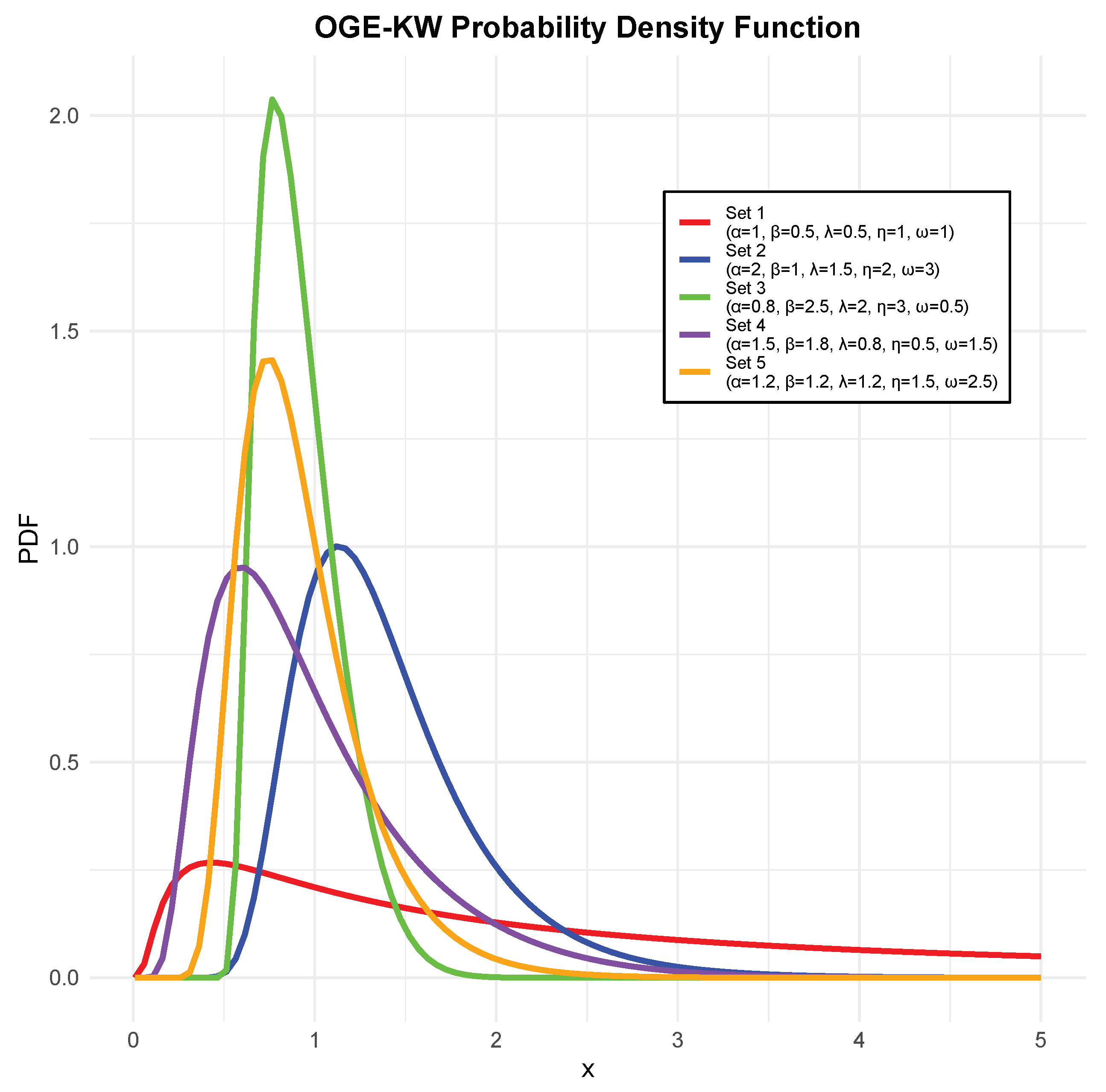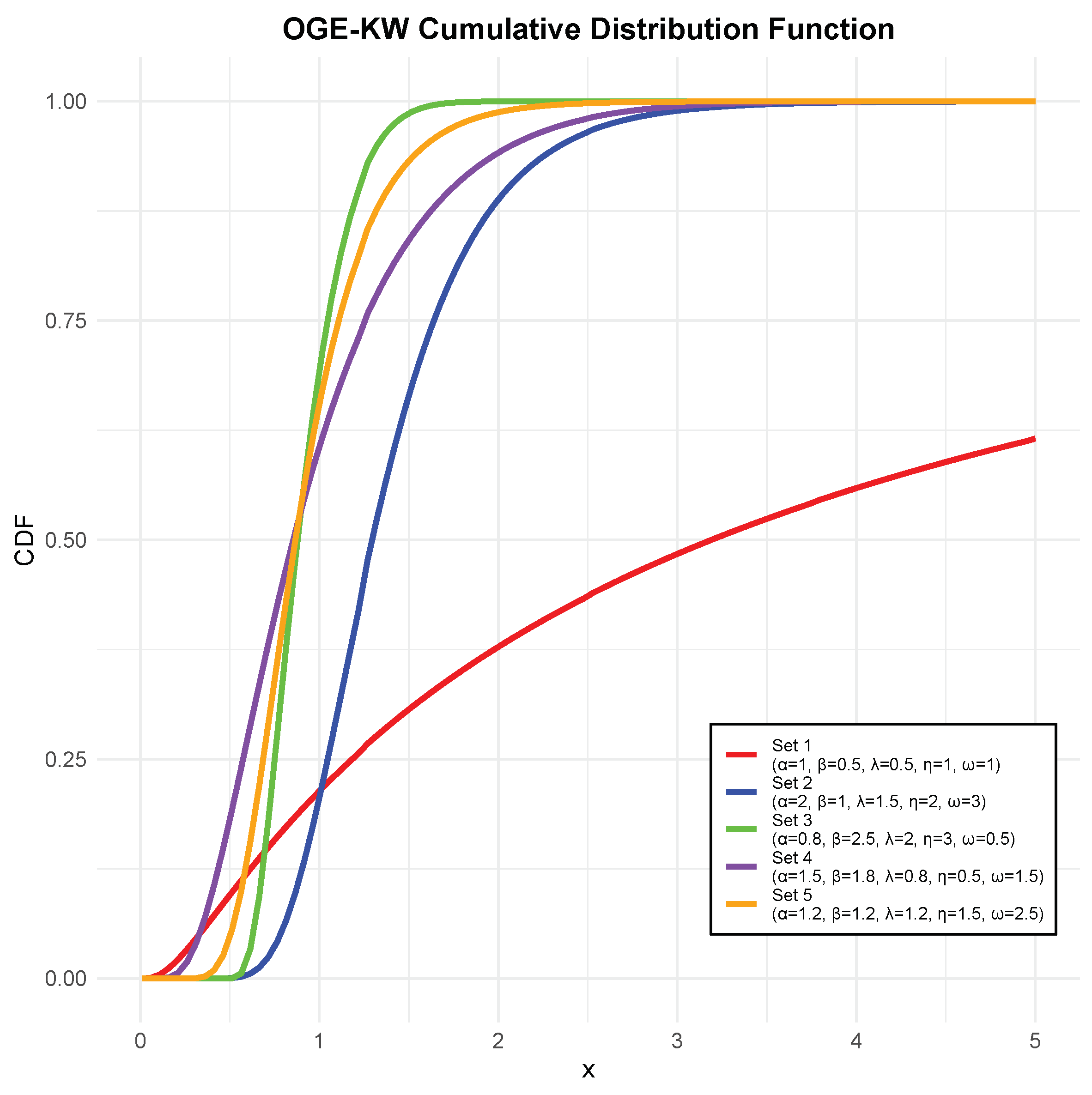Odd Generalized Exponential Kumaraswamy–Weibull Distribution
Abstract
1. Introduction
2. OGE-KW Distribution
2.1. Baseline Distribution
2.2. Odd Generalized Exponentiated Kumaraswamy–Weibull: OGE-KW
- As , we haveHence, .
- As , we haveThus, .
2.3. Quantile and Median
2.4. Survival Function
2.5. Hazard Rate Function
3. Statistical Properties
3.1. Existence and Characterization of Moments
3.2. Existence of Moments
Characterization by Moments
3.3. Moments
3.4. Moment-Generating Function and Moments
- (a)
- The gamma function term must be finite, which requires .
- (b)
- The series must converge, which happens if .
- -
- The gamma function condition requires to be finite, which holds for .
- -
- The infinite sum condition ensures that the tail of the summation does not diverge. The series converges only if .
- -
- The stricter of these two conditions is , ensuring both constraints are met. Thus, the MGF exists if and only if .
3.5. Order Statistics
3.6. Extreme Order Statistics
4. Parameters Estimation
4.1. Maximum Likelihood Estimation
4.2. Numerical Methods and Convergence
- (a)
- Existence and Uniqueness: The existence and uniqueness of MLEs for the OGE-KW distribution are addressed in Theorem 2 and the subsequent discussion on uniqueness.
- (b)
- Differentiability: The log-likelihood function must be twice continuously differentiable in a neighborhood of the true parameter values. This condition is satisfied for the OGE-KW distribution due to the smooth nature of its density function, as noted in Theorem 3, Condition (b).
- (c)
- Concavity: The local concavity of the log-likelihood function near the true parameter values ensures the Newton–Raphson method converges to a local maximum. This is related to the discussion on uniqueness following Theorem 2.
- (d)
- Starting Values: The initial guess should be sufficiently close to the true MLEs. In practice, multiple starting points may be used to increase the likelihood of finding the global maximum.
- (e)
- Rate of Convergence: Under the above conditions, the Newton–Raphson method exhibits quadratic convergence [31]. However, the actual rate may vary in practice, depending on the specific parameter values and sample characteristics.
4.3. Existence, Uniqueness, and Consistency of MLEs
4.3.1. Existence of MLEs
4.3.2. Uniqueness of MLEs
4.3.3. Consistency of MLEs
- (a)
- The model is identifiable: distinct parameter values yield distinct distributions.
- (b)
- The log-likelihood function is continuous and differentiable in .
- (c)
- The expected Fisher information matrix is finite and positive definite.
- (d)
- The parameter space can be restricted to a compact set without loss of generality.
- (e)
- The uniform law of large numbers holds, ensuring that
5. Statistical Analysis of Guinea Pigs Data
5.1. Data Description
5.2. Goodness-of-Fit Tests and Model Selection
5.3. Model Selection and Superior Fit Explanation
6. Conclusions
Author Contributions
Funding
Data Availability Statement
Conflicts of Interest
References
- Weibull, W.A. A statistical distribution function of wide applicability. J. Appl. Mech. 1951, 18, 293–296. [Google Scholar] [CrossRef]
- Baharith, L.; Aljuhani, W. New method for generating new families of distributions. Symmetry 2021, 13, 726. [Google Scholar] [CrossRef]
- Guerra, R.; Peña-Ramírez, F.; Bourguignon, M. The unit extended Weibull families of distributions and its applications. J. Appl. Stat. 2021, 48, 3174–3192. [Google Scholar] [CrossRef] [PubMed]
- Lone, M.; Dar, I.; Jan, T. A new method for generating distributions with an application to Weibull distribution. Reliab. Theory Appl. 2022, 17, 223–239. [Google Scholar] [CrossRef]
- Oluyede, B.; Liyanage, G.W. The gamma odd Weibull generalized-G family of distributions: Properties and applications. Rev. Colomb. Estad. 2023, 46, 1–44. [Google Scholar] [CrossRef]
- Shah, Z.; Khan, D.M.; Khan, Z.; Shafiq, M.; Choi, J.G. A new modified exponent power alpha family of distributions with applications in reliability engineering. Processes 2022, 10, 2250. [Google Scholar] [CrossRef]
- Zaidi, S.; Sobhi, M.; El-Morshedy, M.; Afify, A. A new generalized family of distributions: Properties and applications. AIMS Math. 2021, 6, 456–476. [Google Scholar] [CrossRef]
- Eissa, F.H.; Abdulaziz, R.K. The exponentiated Kumaraswamy Weibull distribution with application to real data. Int. J. Stat. Probab. 2017, 6, 167–182. [Google Scholar] [CrossRef]
- Tahir, M.H.; Nadarajah, S. Parameter induction in continuous univariate distributions: Well-established G families. An. Acad. Bras. Ciências 2015, 87, 539–568. [Google Scholar] [CrossRef]
- Tahir, M.H.; Cordeiro, G.M. Compounding of distributions: A survey and new generalized classes. J. Stat. Distrib. Appl. 2015, 3, 13. [Google Scholar] [CrossRef]
- Eling, M. Fitting insurance claims to skewed distributions: Are the skew-normal and skew-student good models? Insur. Math. Econ. 2012, 51, 239–248. [Google Scholar] [CrossRef]
- Kazemi, R.; Jalilian, A.; Kohansal, A. Fitting skew distributions to Iranian auto insurance claim data. Appl. Appl. Math. Int. J. 2017, 12, 790–802. Available online: https://digitalcommons.pvamu.edu/aam/vol12/iss2/10 (accessed on 25 March 2025).
- Mahmoud, M.; El-Damrawy, H.; Abdalla, H. A new class of skew-normal distribution: Tanh-skew normal distribution and its properties. Int. J. Sci. Res. Sci. Technol. 2021, 5, 31–44. Available online: https://ijsrst.com/home/issue/view/article.php?id=IJSRST20584 (accessed on 25 March 2025).
- Barakat, H.M. A new method for adding two parameters to a family of distributions with application to the normal and exponential families. Stat. Methods Appl. 2015, 24, 359–372. [Google Scholar] [CrossRef]
- Miljkovic, T.; Grün, B. Modeling loss data using mixtures of distributions. Insur. Math. Econ. 2016, 70, 387–396. [Google Scholar] [CrossRef]
- Shahbaz, M.; Shahbaz, S.; Butt, N. The Kumaraswamy inverse Weibull distribution. Pak. J. Stat. Oper. Res. 2012, 8, 479–489. [Google Scholar] [CrossRef]
- Kumaraswamy, P. Generalized probability density function for double-bounded random processes. J. Hydrol. 1980, 46, 79–88. [Google Scholar] [CrossRef]
- Cordeiro, G.; Ortega, E.; Nadarajah, S. The Kumaraswamy Weibull distribution with application to failure data. J. Frankl. Inst. 2010, 347, 1399–1429. [Google Scholar] [CrossRef]
- Gupta, R.D.; Kundu, D. Generalized exponential distribution: Existing results and some recent developments. J. Stat. Plan. Inference 1999, 137, 3537–3547. [Google Scholar] [CrossRef]
- El-Damcese, M.A.; Mustafa, A.; El-Desouky, B.S.; Mustafa, M.E. The odd generalized exponential Gompertz. arXiv 2015, arXiv:1507.06400. [Google Scholar] [CrossRef]
- Tahir, M.H.; Cordeiro, G.M.; Alizadeh, M.; Mansoor, M.; Zubair, M.; Hamedani, G.G. The odd generalized exponential family of distributions with applications. J. Stat. Distrib. Appl. 2015, 2, 1. [Google Scholar] [CrossRef]
- Maiti, S.; Pramanik, S. Odds Generalized Exponential- Exponential Distribution. J. Data Sci. 2015, 13, 733–754. [Google Scholar] [CrossRef]
- Garg, M. On distribution of order statistics from Kumaraswamy distribution. Kyungpook Math. J. 2008, 48, 411–417. [Google Scholar] [CrossRef]
- Jones, M. Kumaraswamy’s distribution: A beta-type distribution with some tractability advantages. Stat. Methodol. 2009, 6, 70–81. [Google Scholar] [CrossRef]
- Mitnik, P. New properties of the Kumaraswamy distribution. Commun. Stat.-Theory Methods 2013, 42, 741–755. [Google Scholar] [CrossRef]
- Feller, W. An Introduction to Probability Theory and Its Applications, 2nd ed.; John Wiley & Sons: New York, NY, USA, 1971; Volume 2. [Google Scholar]
- Fisher, R.A.; Tippett, L.H. Limiting forms of the frequency distribution of the largest or smallest member of a sample. Math. Proc. Camb. Philos. Soc. 1928, 24, 180–190. [Google Scholar] [CrossRef]
- Lamu, D.; Yan, R. Reliability estimation of s-out-of-k system with Kumaraswamy distribution based on partially constant stress accelerated life tests. Stat. Theory Relat. Fields 2024, 8, 295–314. [Google Scholar] [CrossRef]
- Rytgaard, H.; van der Laan, M. Targeted maximum likelihood estimation for causal inference in survival and competing risks analysis. Lifetime Data Anal. 2024, 30, 4–33. [Google Scholar] [CrossRef]
- Xu, A.; Fang, G.; Zhuang, L.; Gu, C. A multivariate student-t process model for dependent tail-weighted degradation data. IISE Trans. 2024. [Google Scholar] [CrossRef]
- Ortega, J.M.; Rheinboldt, W.C. Iterative Solution of Nonlinear Equations in Several Variables; Academic Press: New York, NY, USA, 1970. [Google Scholar]
- Wald, A. Note on the Consistency of the Maximum Likelihood Estimate. Ann. Math. Stat. 1949, 20, 595–601. [Google Scholar] [CrossRef]
- Bickel, P.; Doksum, K. Mathematical Statistics: Basic Ideas and Selected Topics, 2nd ed.; CRC Press: Boca Raton, FL, USA, 2015; Volume I. [Google Scholar] [CrossRef]
- Bjerkedal, T. Acquisition of resistance in guinea pigs infected with different doses of virulent tubercle bacilli. Am. J. Epidemiol. 1960, 72, 130–148. [Google Scholar] [CrossRef] [PubMed]




| Statistic | Value |
|---|---|
| Minimum | 0.10 |
| Maximum | 5.55 |
| Median | 1.50 |
| Mean | 1.77 |
| Variance | 1.07 |
| Standard Deviation | 1.03 |
| Coefficient of Variation | 0.59 |
| Parameter | Estimate | Standard Error |
|---|---|---|
| 49.8827 | 0.1003 | |
| 5.5495 | 0.0979 | |
| 14.9509 | 0.1007 | |
| 0.0826 | 0.0038 | |
| 13.1191 | 2.7774 |
| Test | Statistic | p-Value |
|---|---|---|
| Kolmogorov–Smirnov | 0.4079 | |
| Anderson–Darling | 0.3534 | |
| Cramér-von Mises | 0.3398 |
| Distribution | k | AIC/BIC | |||||
|---|---|---|---|---|---|---|---|
| OGE-KW | 10.5055 | 5.6354 | 0.0100 | – | 0.0852 | 10.5594 | 192.3721/196.9254 |
| GE | 3.6288 | – | 1.1271 | – | – | – | 192.4721/197.0254 |
| OGE | 3.0797 | 1.6885 | 0.7698 | – | – | – | 194.1313/200.9613 |
| Weibull | 1.8254 | 1.9960 | – | – | – | – | 195.5796/200.1329 |
| Kumaraswamy–Weibull | 3.1104 | 1.7319 | 0.7683 | 0.9912 | – | – | 196.1312/205.2379 |
Disclaimer/Publisher’s Note: The statements, opinions and data contained in all publications are solely those of the individual author(s) and contributor(s) and not of MDPI and/or the editor(s). MDPI and/or the editor(s) disclaim responsibility for any injury to people or property resulting from any ideas, methods, instructions or products referred to in the content. |
© 2025 by the authors. Licensee MDPI, Basel, Switzerland. This article is an open access article distributed under the terms and conditions of the Creative Commons Attribution (CC BY) license (https://creativecommons.org/licenses/by/4.0/).
Share and Cite
Ferreira, S.S.; Ferreira, D. Odd Generalized Exponential Kumaraswamy–Weibull Distribution. Mathematics 2025, 13, 1136. https://doi.org/10.3390/math13071136
Ferreira SS, Ferreira D. Odd Generalized Exponential Kumaraswamy–Weibull Distribution. Mathematics. 2025; 13(7):1136. https://doi.org/10.3390/math13071136
Chicago/Turabian StyleFerreira, Sandra S., and Dário Ferreira. 2025. "Odd Generalized Exponential Kumaraswamy–Weibull Distribution" Mathematics 13, no. 7: 1136. https://doi.org/10.3390/math13071136
APA StyleFerreira, S. S., & Ferreira, D. (2025). Odd Generalized Exponential Kumaraswamy–Weibull Distribution. Mathematics, 13(7), 1136. https://doi.org/10.3390/math13071136







